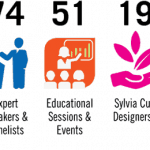
The worst day of the year for the stock market. New tariffs. Inverted yield curves. Do headlines about the economy have you worried? Take a breath, advises Charlie Hall, Ph.D., professor and Ellison Chair in the Department of Horticultural Sciences at Texas A&M University. Because despite a great deal of uncertainty, few news stories provide floral industry professionals with the full context for what’s happening, and what isn’t happening, in the economy right now.
“The current situation is much different today than it was 10 years ago,” at the start of the Great Recession, said Hall, winner of the Society of American Florists’ 2018 Paul Ecke Jr. Award. “I’m not as worried as the current fever pitch in the media might have you believe.”

Charlie Hall, Ph.D.
Hall said many of the news stories focus on the wrong economic indicators — “the performance of the stock market is not a good indicator of the overall health of the economy,” he noted — or on factors that need more background to be fully understood.
Take, for example, reports of inverted yield curves. Last week, the yield on 10-year U.S. Treasury notes fell below those for two-year notes — an inversion that last happened in 2007. The change worried some investors and became the focus of late-night TV shows and a presidential tweet and caused a spike in Google searches for the term “inverted yield curve.”
Hall, however, said some of the angst about inversions may be misplaced, in part because “all of the qualitative easing the Fed has been doing on the economy since the Great Recession, including injecting $85 billion a month into the U.S. economy. That puts a drag on long-term notes. If you take that into account, the curve wouldn’t even be inverted.“
“Yes, an inverted yield curve has been an indicator of recessions in the past, but things are different today,” he added.
Hall also noted that consumer spending remains strong — stronger in the first half of the year than many economists had predicted. (A recent SAF survey indicated floral professionals are feeling that effect, too, with more than 60 percent expressing optimism about 2019 sales.)
Still, uncertainty remains, particularly when it comes to some of the current administration policies, including tariffs with China and the effect on U.S. consumers and the ongoing ramifications of last year’s tax cut — a move Hall said has added to the national debt without delivering upon some of the promised benefits, including corporate investment in equipment and infrastructure.
As for the question Hall fields often from industry colleagues — “When will the U.S. enter its next recession?” — Hall said he puts the chances of the country moving into a recession this year at about 33 percent and “50/50 by next year.”
By 2021, “it’s about 80 percent,” he said. “I think by then we’ll see a slowdown in the labor market and housing, all these factors start accumulating.”

Paul Goodman, CPA, MBA, PFCI
In other words, a slowdown of some type is inevitable, and part of economic cycles, which means floral professionals in all segments should start preparing now.
“There is still time for folks to do what’s needed and to make strategic investments,” he said. “Don’t be overleveraged. Manage your working capital. And make sure that your value proposition to your customers is very clear. Also, don’t back down on marketing. That’s often the first thing people cut, and I think that’s a mistake. When things are tight, you can make a lot of headway by marketing when no one else is.”
That’s advice Floral Management contributor Paul Goodman, CPA, MBA, PFCI echoes.
“Florists need to be focused on being profitable now,” said Goodman. “A recession will hurt. Better to have a cushion going in and then be prepared to cut expenses quickly along with any sales decline.”
You can hear more economic insight and planning advice from both Hall and Goodman next month at SAF Amelia Island 2019. Find out more and register today.
Mary Westbrook is the editor in chief of Floral Management.






